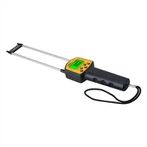Precautions and industrial applications of infrared thermometers
played an important role. In the past 20 years, non-contact infrared human body thermometers have developed rapidly in technology, their performance has been continuously improved, their functions have been continuously enhanced, their varieties have continued to increase, and their scope of application has also continued to expand. Compared with contact temperature measurement methods, infrared temperature measurement has the advantages of fast response time, non-contact, safe use and long service life. Non-contact infrared thermometers include three series: portable, online and scanning, and are equipped with various options and computer software. Each series has various models and specifications. Among various types of thermometers with different specifications, it is very important for users to correctly select the model of infrared thermometer. What issues should be paid attention to when using an infrared thermometer? In order to measure temperature, aim the instrument at the object to be measured. , press the trigger to read the temperature data on the LCD of the instrument, ensuring that the ratio of distance to spot size, and field of view are properly arranged.
Things you should pay attention to when using infrared thermometers:
1. It only measures the surface temperature, and the infrared thermometer cannot measure the internal temperature.
2. Temperature measurement cannot be carried out through quartz glass with a wavelength above 5um. Glass has very special reflection and transmission characteristics, which does not allow accurate infrared temperature readings. But the temperature can be measured through the infrared window. Infrared thermometers are best not used for temperature measurement on bright or polished metal surfaces (stainless steel, aluminum, etc.).
3. Locate hot spots. To find hot spots, the instrument aims at the target, and then scans up and down on the target until the hot spots are determined.
4. Pay attention to environmental conditions: steam, dust, smoke, etc. It blocks the optical system of the instrument and affects accurate temperature measurement.
5. Ambient temperature. If the thermometer is suddenly exposed to an ambient temperature difference of 20°C or higher, allow the instrument to adjust to the new ambient temperature within 20 minutes.
The correct choice of infrared thermometer. Choosing an infrared thermometer can be divided into three aspects:
(1) Performance indicators, such as temperature range, spot size, working wavelength, measurement accuracy, window, display and output, response time, protective accessories, etc.;
(2) Environmental and working conditions, such as ambient temperature, windows, display and output, protective accessories, etc.;
(3) Other aspects of selection, such as ease of use, maintenance and calibration performance, and price, also have a certain impact on the choice of thermometer.
Industrial Applications of Infrared Thermometers
Electricity: temperature protection and signal transmission of coal-fired power plants, gas-fired heating power plants, hydropower stations, nuclear power plants, district heating pipe networks, large power transformers, etc.
Metallurgy: aluminum factory, copper factory, steel factory, etc.
Petrochemical: oil production, oil pipelines, petrochemical plants, refineries.
General industry: Freezer factory, air conditioning factory, refrigerator factory, brewery, pharmaceutical factory, automobile factory.
Temperature component manufacturer: platinum resistor, thermocouple and compensation wire and cable, temperature switch, temperature sensor manufacturer.
Transportation: aircraft maintenance at airports, maintenance of large-scale transportation power systems, and ocean shipping as in-service maintenance measurement methods.





